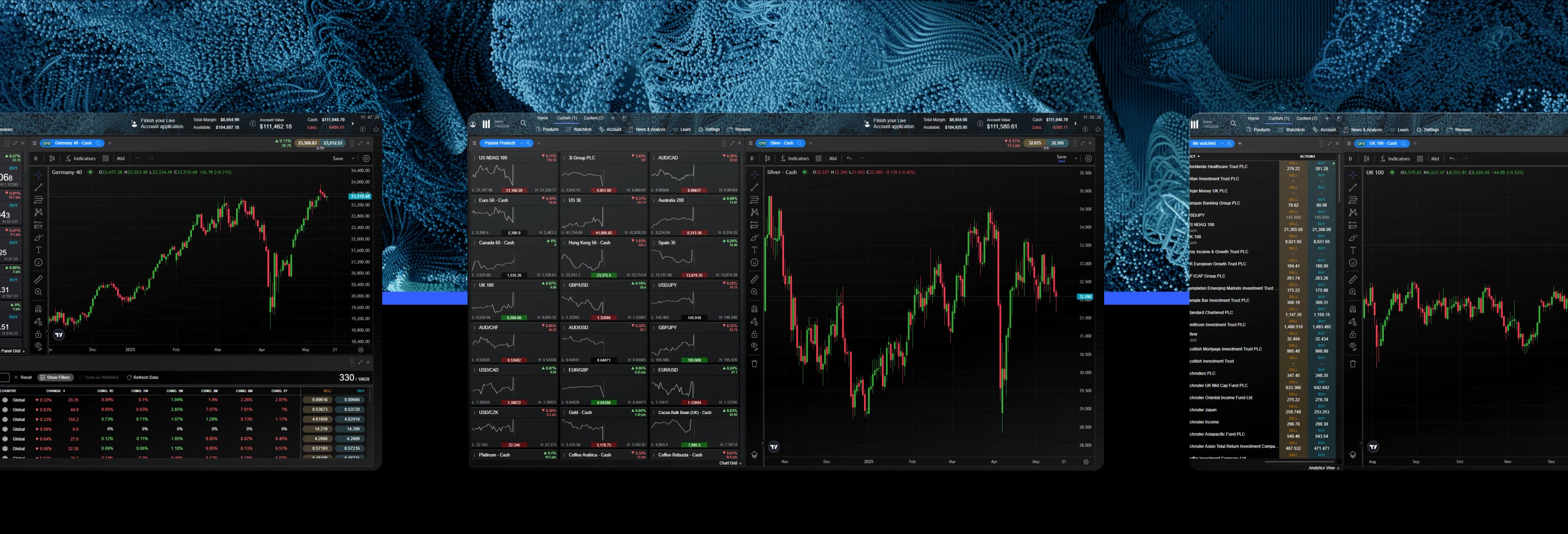
What are bonds and how do you trade them?
Treasuries are often seen as a relatively stable and low-risk investment within the financial markets, which can be traded in uncertain times. In this article, discover the different types you can trade and worldwide (including tax-free bonds), how to get started, and which can potentially provide stable returns on average. We compare securities around the world to find a bond trading opportunity that may be suitable for you.
What are bonds?
Bonds are a fixed-income instrument or debt security that represent a lending agreement between a buyer and seller, issued by either the government or a private corporation – effectively an ‘IOU’. Unlike shares that trade on a country’s national stock exchanges, most treasuries are traded over the counter (OTC).
The borrower promises to pay back the bond to the lender at a prior agreed date, and until then, are usually required to pay fixed or variable interest rate payments. Investors who purchase a security are lending money to the issuer for a specified period of time. Their duration can be short-term, medium-term or long-term depending on the individual treasury, and the funds are used to finance a project or operation.
The treasuries market is open 24 hours a day, from Sunday night to Friday evening, due to overlapping hours for each country and stock exchange. It’s generally a popular way for investors to diversify their portfolio, due to the lower, more stable returns.
What are the different types?
Types of bonds vary depending on the issuer, but most follow the same principle with these key features:
Issue price: the price at which the issuer sells
Maturity date: the agreed-upon date the issuer pays back the bond
Face value: the money the security is worth at maturity
Coupon rate: the interest rate that the issuer pays on the bond’s face value
Coupon date: the date the issuer makes the interest payments
Government bonds
These are a loan to the government for an agreed rate of interest in return. As with all assets, it’s for an agreed period of time, with the interest paid at regular periods, and the original investment returned at the end of the time period, also known as the maturity date. In the UK, these are referred to as gilts, whereas in the US, they are known as treasuries.
Corporate bonds
These involve loaning capital to a company, as a form of debt security issued by a particular corporation and sold to investors. These are often used for a company operation or future project, although they may be considered a riskier type of bond as taxes can’t be used to pay and companies are more likely to default then, causing higher interest rates.
Municipal bonds
On the other hand, these are issued by cities or countries and other local institutions to finance infrastructure and expenditures. These often include schools, bridges or roads. An appeal of these is that the coupons paid out are usually tax-free.
High-yield bonds
Also known as "junk bonds", these are of a lower status than others and tend to come from start-up businesses. Therefore, they have lower credit ratings and are more likely to default, making them slightly riskier investments. However, they can still be a good way to diversify your portfolio.
Are they a good investment?
Treasuries can be used as a partial hedging strategy for when other equities, such as shares in the stock market, are experiencing a period of market volatility. If you encounter losses on other assets, then these may be partially offset by any profits that you make through debt investments as they sometimes have a negative correlation to riskier assets such as stocks.
Movements within the stock market can sometimes affect bond prices, and in particular, yields are sensitive to changes in interest rates. When interest rates fall, the interest rate on the treasury becomes more attractive. On the other hand, if rates go up, bond prices tend to fall, so there is less purpose for trading. Although this can increase the chance of risk, traders can use these types of assets to hedge against interest rate movements.
Overall, the treasury market produces returns of around 5-6%, according to CNN. Although this may seem low compared to the stock market’s average of around 10%, they also come with less risks and are considered by many to be a more stable asset. Therefore, treasuries may be suitable for an investor who is looking for slow and steady returns, rather than quick and volatile ones.
How to trade bonds
Choose your product.
You can trade CFDs on interest rate securities, and trade on margin, which enables you to enter a position that is larger than your initial account balance.
Research the treasuries market.
Find out what fundamental factors have an effect on prices, including interest rates, yields, credit risk, and credit rating changes.
Narrow down your instrument.
Out of the 0+ that we offer, this could include treasuries from the US, Europe, or a more generalised bond ETF.
Decide whether you want to buy or sell.
Depending on whether you go long or short, define your entry and exit positions on the trading chart.
Make use of risk-management tools.
The market can be volatile, so some traders take advantage of stop-loss orders to minimise their capital loss.
What are some trading strategies you can use?
Traders may opt for either short-term or long-term bond trading strategies depending on their overall goals. So, how does bond trading work? We explore several options below to help you get started.
Shorting
As discussed, when interest rates rise, treasuries may become less appealing to a trader as their prices drop. If you believe that this is about to happen, you could ‘sell’ your chosen asset in order to open a short position which will profit when the price moves downwards. Then, if the price indeed drops as predicted, you could close out the trade by opening a long position to ‘buy’ back the asset at a lower price. Your profit would be the difference in price between the two.
Short selling is a risky strategy and may result in losses if the position is not managed properly, so in order to prevent this, you could place a stop-loss order on any open positions, which can help to limit your losses.
Buy-and-hold approach
In an opposite strategy to the one above, if you think that interest rates are about to drop, which will drive bond prices higher, you could open a long position (also known as a buy and hold approach). You would make a profit if your trade increases in value and you close out the trade or ‘sell’ the asset for a higher price. However, remember that the markets can move in either direction and there is no guarantee that your prediction will be correct.
Hedging
Another trading example is one of hedging. As prices can be affected by both interest rates and inflation, opening a trade is usually an efficient way to hedge against possible downturns in the stock and treasuries markets. A trader could potentially make a profit from the movement in prices through income generated from stocks or other assets held in your existing portfolio.
10 bonds to watch
Traders looking to get exposure to fixed income could open a long position on (buy) individual assets. Depending on factors like time horizon, risk profile and available capital, a mutual fund or exchange-traded funds (ETFs) may also be among options worth considering.
1. US T-Bond
This is a treasury derivative based on the relative value of the fixed-interest, US debt security, which has a maturity of between 10 and 30 years. It often increases in value in times of economic or political instability as investors seek a safe haven to keep their money safe.
2. UK Gilt
Our instrument is based on the underlying security issued by the British government, which can have a maturity of five, ten, or 30 years. The political party has never failed to make interest or principal payments when they are due, therefore this is considered as one of the safest investments a trader can make. The treasury is made up of both conventional and index-linked gilts.
3. Euro Bund
This instrument is based on the underlying price of the Euro Bund issued by the German federal government, and it’s one of our most popular treasury products. In most cases, these long-term options have a maturity range of between 8 and 10 years.
4. US T-Note 2 YR
Our treasury note is based on the US debt security with a fixed interest and maturity of around two years. It’s included on the shorter end of the yield curve and provides a good indication of the health of the US economy.
5. Euro Bobl
The Bobl is Germany’s version of gilts and is based on the underlying value of a collection of medium-term German federal issued securities. Its underlying assets have a maturity of between 4 and 6 years. Bobl futures are some of the most popular fixed-income securities in the world.
6. US T-Note 10 YR
Our US T-Note 10 Year – Cash instrument is based on a US debt obligation issued by the government with a maturity of 10 years. These pay interest at a fixed rate once every six months, paying the face value to the holder when it matures.
7. iShares Core UK Gilts UCITS ETF
This ETF’s aim is to track the performance of an index made out of GBP denominated bonds. It has a fixed interest rate and helps investors to have a diversified exposure to government securities, as it provides single country exposure only.
8. Vanguard Total Bond Market ETF
The aim of this fund is to track the performance of a broad, market-weighted index in the US dollar-denominated market. It’s an intermediate-term instrument that can offer a potential for investment income.
9. iShares iBoxx $ High Yield Corporate Bond ETF
This is one of the most commonly used ETFs for high-yield securities. It seeks to track the investment results of an index composed of US dollar-denominated high-yield corporate-grade securities. Investors often use it for income.
10. SPDR Barclays High Yield Bond ETF
This fixed-income instrument provides exposure to US dollar-denominated junk bonds with above average liquidity. The index that it’s based on is a more cost-efficient method than accessing individual treasuries.
What are the advantages?
You receive income through interest payments.
By reselling before the maturity date at a higher price, you can make profits.
They are often considered less risky or volatile than stocks.
Treasuries are fairly liquid assets – gilts, in particular, are liquid, whereas corporate ones are slightly less.
What are the disadvantages?
Rising inflation could also cause the bond value to fall.
Any financial asset being traded, or invested in, carries risk when trading on margin, since profits are magnified equally as losses.
Holding a position overnight via a derivatives broker will incur overnight holding costs, and there could be economic news that affects the treasury’s price.
Explore our bond trading platform
You can start trading CFDs on more than bonds, interest rates, debt obligations, and treasury notes offered on our Next Generation platform. Some of our most popular instruments trade up to 23 hours a day, giving you a wider exposure to the markets.
As well as ‘cash’ instruments, you can also take a position on forwards (based on the underlying futures price), which are an agreement between a buyer and seller to exchange a treasury at a set price at a future date.
All financial trading involves risk, including treasuries. Gilts, however, are considered by some investors to be relatively safer, as they have lower interest rates than corporate bonds and are generally tax-free, similar to municipal bonds.


